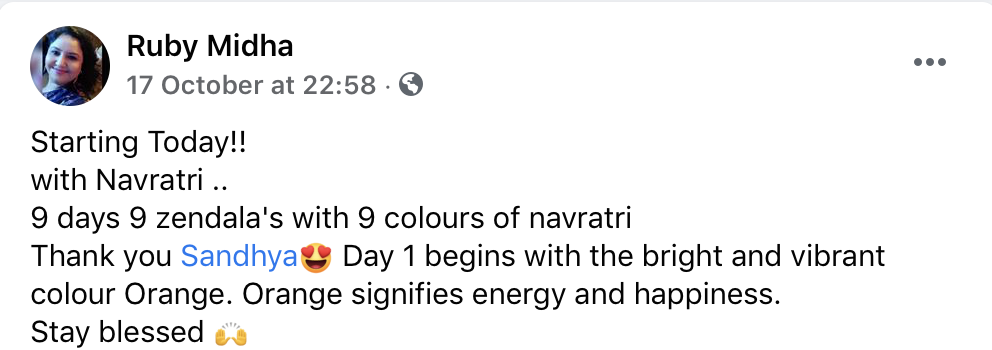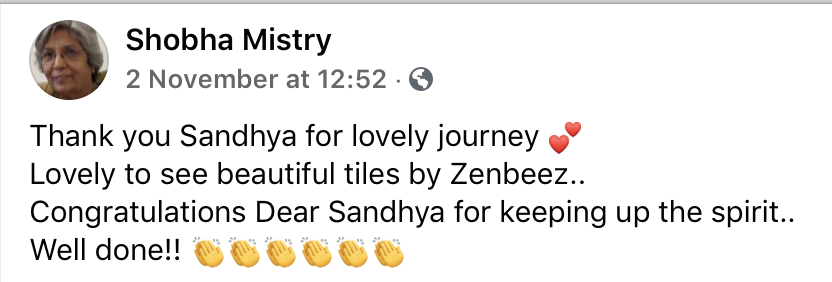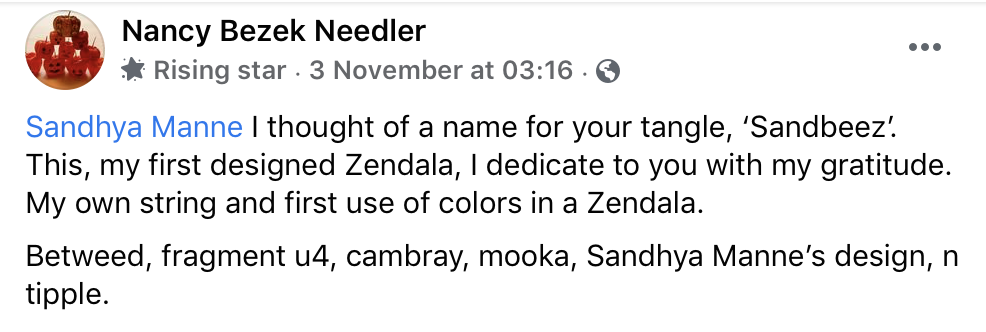JANTAR MANTAR, Jaipur
Jantar Mantar is an observatory, built by the Maharaja of Jaipur in the year 1737. Maharaja Sawai Jai Singh was born in 1688 A.D. and succeeded the throne of Amber at the age of eleven, he ruled the state from 1699 to 1743. In 1728 he founded the capital city of Jaipur about 200 km southwest of Delhi. Sawai Jai Singh was inclined towards astronomy from an early age and studied the works of Hindu, Muslim and European astronomers, particularly those of Ptolemy, Ulugh Beg and La Hire. He also translated well-known treatise on the subject to Sanskrit and Persian.
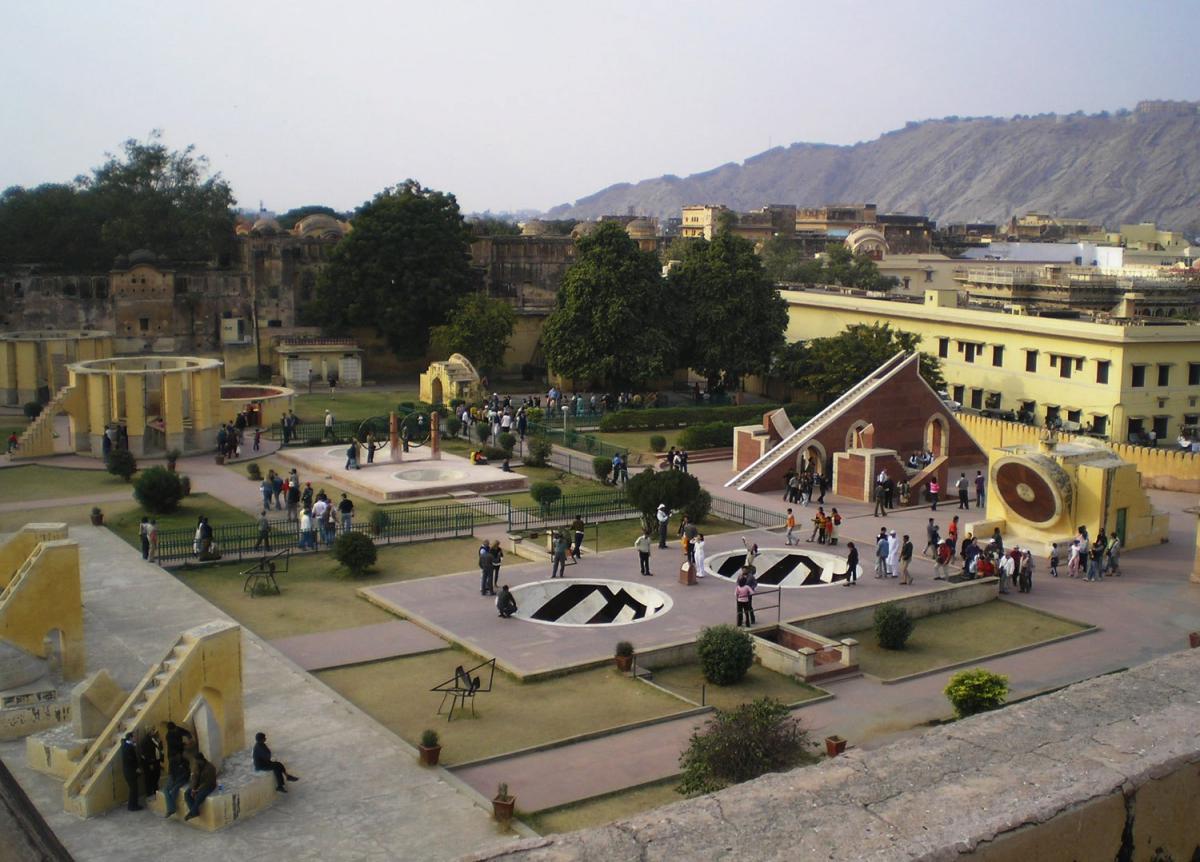
Jantar Mantar at Jaipur
Wishing to improve the Indian calendar and the ability to precisely locate the Sun, and for purposes of map-making, he often sent his staff across the sea to collect information on astronomy. Samrat Jagannath and Pt. Kewal Ram helped him in his endeavors. After experimenting on the small instruments made with brass, Jai Singh adapted and added to the designs of earlier sight-based observatories to create architecture for astronomical measurement that is unsurpassed. In his view, larger instruments could provide more exact and precise reading than smaller ones of brass. He first built a large observatory with instruments of masonry in Delhi in 1724 A.D. There after, he built observatories at Jaipur, Ujjain, Banaras (Varanasi) and Mathura. All but the Mathura observatory still exists.
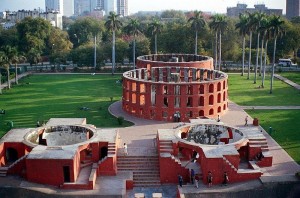
Jantar Mantar at Delhi
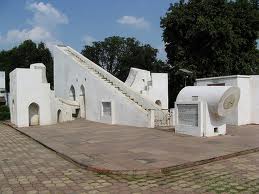
Jantar Mantar at Ujjain
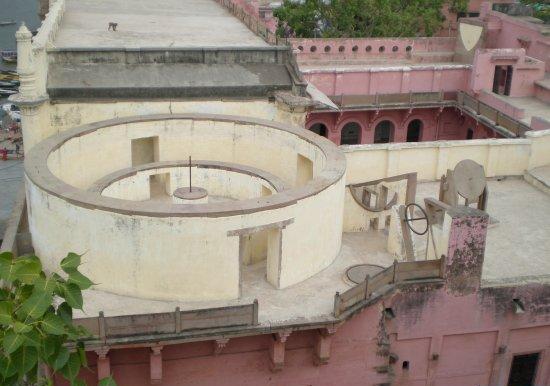
Jantar Mantar at Varanasi
The observatory at Varanasi is spectacularly located overlooking the bathing ghats on the Ganges; it is next to the Dasaswamedh Ghat, one of the more popular and important ghats in Varanasi. The observatory sits high above the water next to the palace that Jai Singh built there. The instruments are small, compared to those at Jaipur and Delhi, and few in number, but there is a very nice equatorial sundial in working order. It is small enough so that one person can easily make measurements. The setting alone makes the trip worthwhile.
The Jantar Mantar, or "House of Instruments" at Jaipur is the largest of the observatories and contains sixteen instruments. The Jaipur observatory was completed in 1734 A.D. It contains almost all of the Raja’s instruments with a greater degree of precision. The “Rashivalaya Yantra” (Zodiac Circle or Ecliptic Instrument) is found nowhere else except in Jaipur. Sawai Jai Singh himself used to take astronomical readings in this observatory situated near his palace. The observatory was renovated in the time of Maharaja Madho Singh, in 1901 A.D. Pt. Chandradhar Sharma Guleri, Pt. Gokul Chandra Bhavan and Lieutenant A.ff. Garrett carried out the renovation. Stone and lime plastered marking plates were replaced with marble.
Following 16 instruments were built in Jaipur observatory and they all are in good and working condition for exact calculation of planets and stars…
1. Laghu Samarat Yantra
2. Dhruva Darshak Pattika
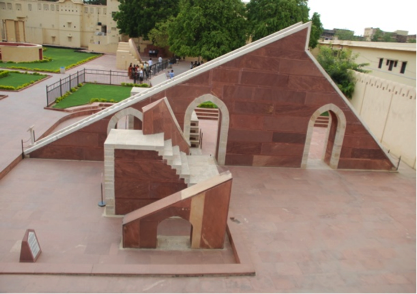
Laghu Samarat Yantra and Dhruva Darshak pattika
3. Nadi Valaya Yantra
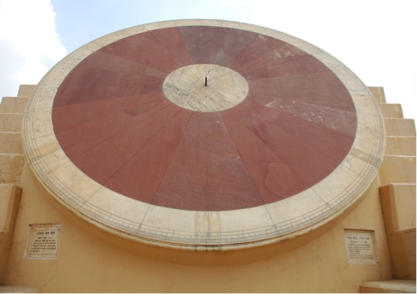
Nadi Valaya Yantra
4. Palbha Yantra
5. Kranti Vritta Yantra
6. Yantra Raj Yantra
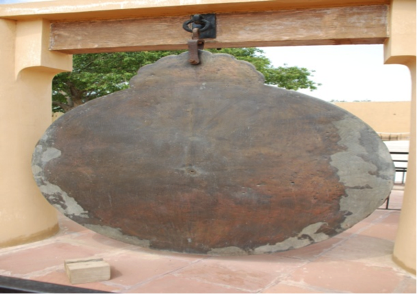
Yantra Raj Yantra
7. Unnantansh Yantra
8. Dakshi Nottar Bhitti Yantra
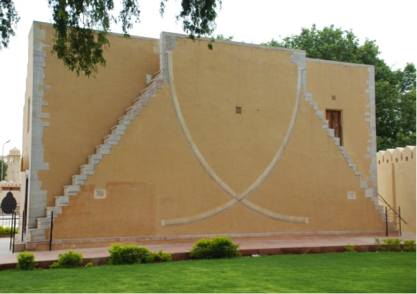
Dakshi Nottar Bhitti Yantra
9. Shasthansh Yantra
10. Chakra Yantra
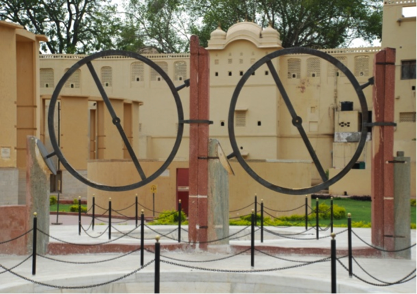
Chakra Yantra
11. Kapali Yantra
12. Ram Yantra
13. Digansh Yantra
14. Vrihat Samrat Yantra
The largest instrument is the Samrat Yantra or equatorial sundial. It consists of a straight 90 foot high ramp, or gnomon, which is aligned north south and elevated at an angle of 27 degrees above the northern horizon. The latitude of Jaipur is 27 degrees north, thus the ramp points toward the celestial pole. On each side of the ramp there are two quarter circles, or quadrants, fashioned in masonry. The quadrants are centered on the nearest edge of the ramp.
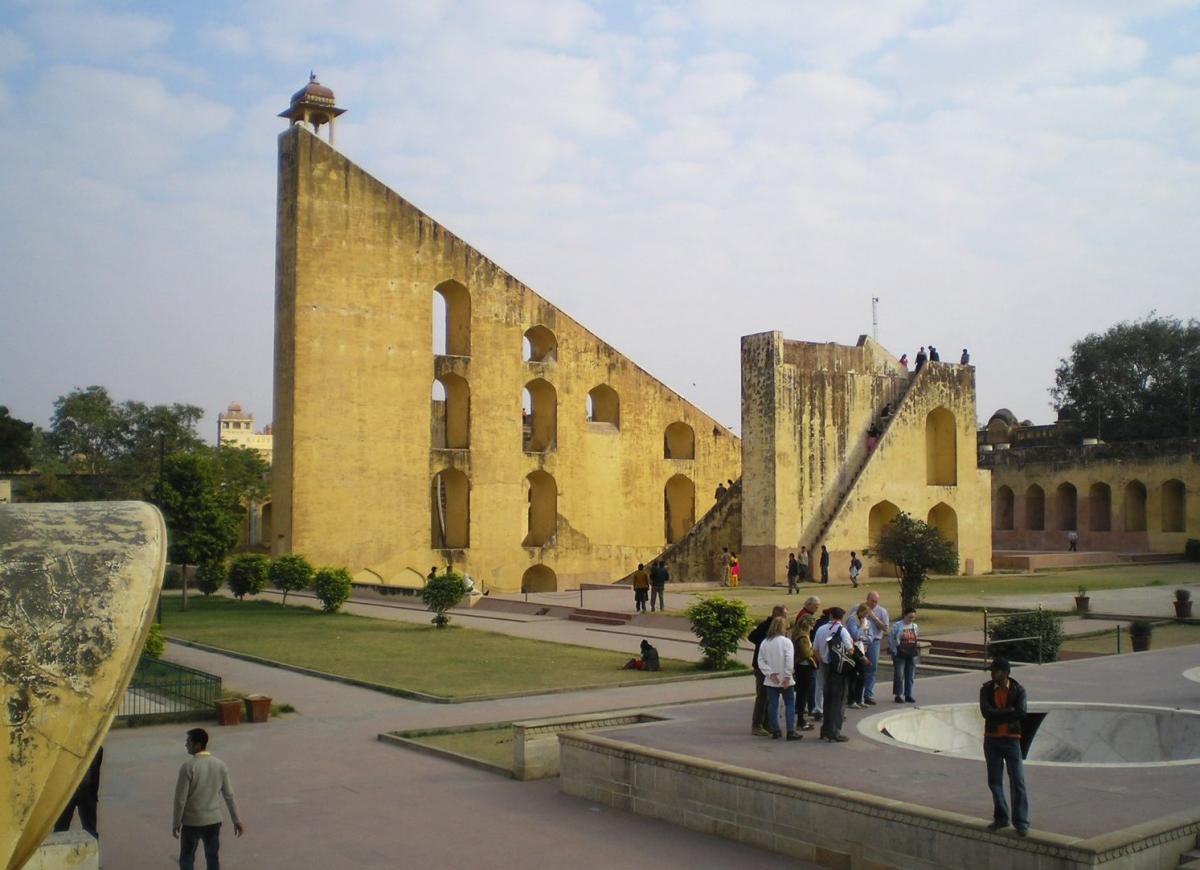
Vrihat Samrat Yantra
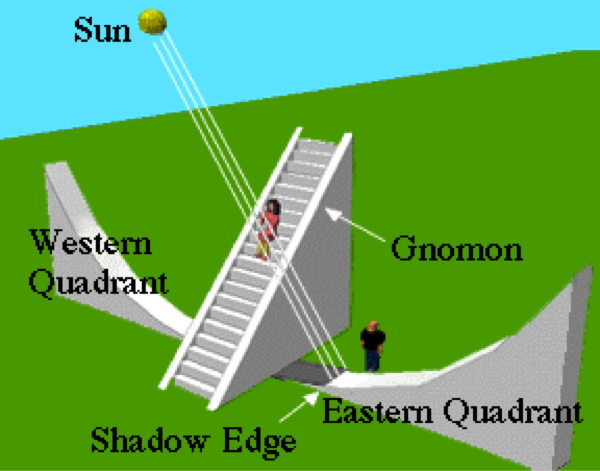
Drawing of the small equatorial sundial showing the shadow, quadrants, gnomon, and Sun rays.
The Sun casts a shadow of the ramp edge on one of the quadrants; before noon the shadow is cast on the quadrant to the west of the ramp, and afternoon it is cast on the eastern quadrant. The local solar time can be read from markings on the quadrant at the edge of the shadow. With careful measurements one can measure the local solar time to a precision of two seconds. There is a stairs up the ram and one can move a stick up and down the edge of the ramp until the shadow of the stick falls on the appropriate edge of the quadrant. Markings on the ramp can then be read, at the location of the stick, which give the celestial longitude of the Sun. Repeated determination of the longitude of the Sun allows one to determine the time that the Sun crosses the celestial equator and thus the date and time of the equinoxes.
15. Jai Prakash Yantra
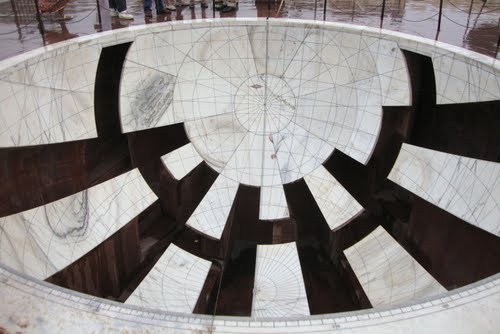
One of the hemispherical depressions of the Jai Prakash Yantra. The dark areas are passages.
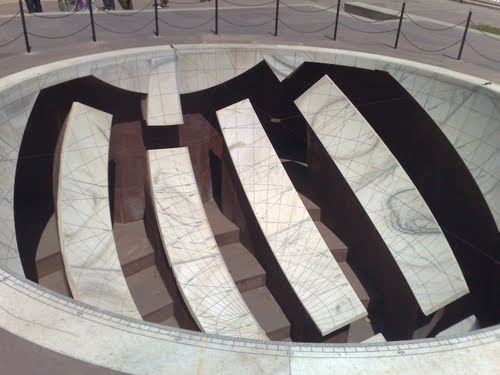
Second hemispherical depressions of the Jai Prakash Yantra. The dark areas are passages.
One of the more interesting instruments is the Jai Prakash Yantra. One part of the instrument is a hemisphere, fashioned of mortar, sunk in the ground, sliced with passages so that the instrument reader can be close to the remaining segments of the hemisphere. The second part of the instrument is another hemisphere, again fashioned of mortar, sunk in the ground, sliced with passages to compliment the first instrument. The parts of the hemisphere in the first instrument that are missing because of the passageways are present in the second and visa versa. The hemisphere surfaces are of marble and are scribed with celestial latitude and longitude lines. A small marker is suspended at the center of each hemisphere by wires. The location of the shadow of the sun, and thus the celestial coordinates of the sun, can be read from the markings on the hemisphere segments. If the shadow happens to fall in a passageway in one instrument it will fall on the marked hemisphere segments in the other instruments.
16. RashiValaya Yantra
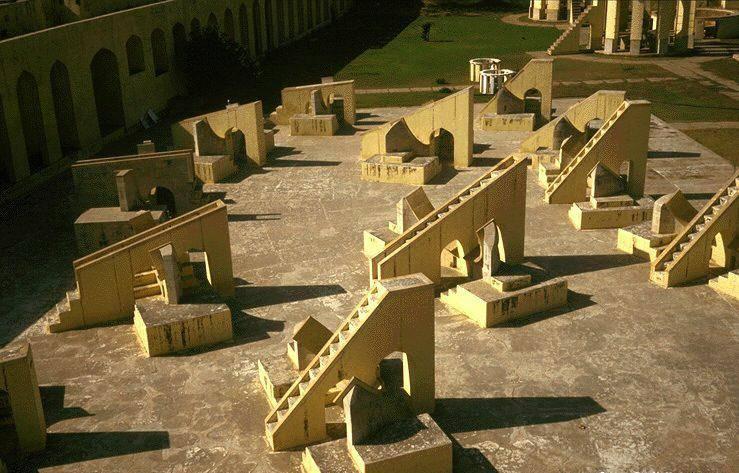
RashiValaya Yantra
There are also twelve smaller instruments similar in design to the equatorial sundial. They are unique in that they are constructed to help read the ecliptic coordinates of celestial objects. Because the ecliptic pole is not a fixed point relative to an observer on the rotating Earth, one cannot align a single gnomon to always point to the ecliptic pole. The angle of the gnomon would have change with time to point to the ecliptic pole. As an approximate solution to this problem Jai Singh built twelve "equatorial" sundials with differing gnomon slopes. Thus at any one time one could use the dial with the angle closest to the true angle of elevation of the ecliptic pole and use that dial to read the ecliptic coordinates of celestial objects. This would be particularly valuable for tracking the Sun and planets. There is one instrument for each sign of the zodiac.
They don’t have rooms, they don’t have seating and they are full of measurement information, indexes, scales and geometrical forms that correspond to their function as direct-sight observatories. The bold designs and instruments completely engulfs the observer..
Sources:
jantarmantar.org
wikipedia.org
bomhard.de
jaipur.org.uk
museumsrajasthan.gov.in
hartwick.edu/hartleyc/jantar.html
Comments are closed.






















